A pear tree that doesn’t bear fruit for eating – isn’t that a bit of a contradiction? Well, not all pear trees are made alike. The ornamental pear tree, although it’s not fruit bearing (well, the kind you would eat), does show off a display of delightful flowers. The leaf colours might even make you think of an artist’s palette as the seasons change.
If you’re considering adding an ornamental pear tree to your garden, but need some guidance with regards to planting and care, we’ve got some great tips for you.
More...
Introducing the Ornamental Pear Tree

Ornamental pear trees (often called Callery Pear) bring joy all year round. This deciduous tree delights with spring florals, beautiful autumn leaves and are hardy all year round. Most of the varieties are narrow and upright, which makes them perfect for driveways, borders and feature plants.
They are quite easy to care for too. Pyrus calleryana is a variety of pear tree that is native to Korea and China and was introduced into western horticulture in 1908.
The Callery Pear was named after Joseph-Marie Callery, who sent specimens from China to Europe in the 1800s. It was recognised as an ideal tree for planting because of its beautiful white flowers and fast growth.
Ideal Growing Conditions
Ornamental pear trees can be planted at any time of the year. They are happiest in a spot that gets full sunlight and must be planted in well-draining soil.
Some varieties of ornamental pear tree are vulnerable to wind damage, so be sure to place them somewhere in the garden that is protected.
Depending on which variety of ornamental pear tree you go for, they can range between 6 to 15 metres in height. They are fast growing, and many of the varieties have a narrow shape, making them quite upright.
Special features of the Callery Pear
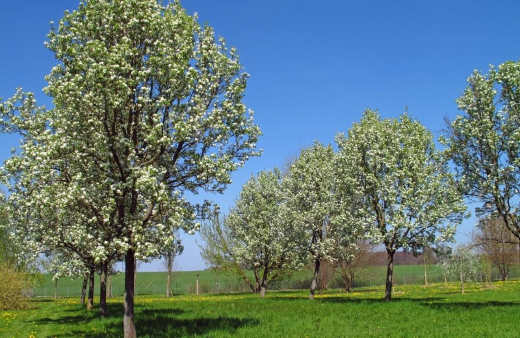
Many pear trees actually produce fruit, like the bosc pears, which is small in size and quantity. Thinking of tasting the fruit? We wouldn’t recommend it – maybe leave it for the wildlife instead. The reason many people choose an ornamental rather than a fruiting pear tree is because they are simple to care for.
Ornamental pear trees (Pyrus calleryana) are loved for their bold flowers which arrive during the springtime and their leaf colour is brilliant as the weather cools down, in shades of red, bronze and purple.
Perhaps part of your grand garden plan is to attract wildlife that you can enjoy and nurture, along with your plants. We’ve got 6 steps to help make your garden a haven for birds and insects. The great news is, this improves the overall health of your garden too.
Types of Ornamental Pear Trees
Pyrus calleryana ‘Bradford’Bradford ornamental pear is suitable for a wide range of climate conditions. They have heart-shaped leaves, which turn multi-coloured in late autumn and boast a huge display of white flowers in spring. This variety likes well-drained soil and to live in a sunny position. In milder climates the tree can be semi-evergreen. It can adapt to a wide range of conditions from quite dry, to slightly alkaline and/or wet soil. |  Source: bhg.com |
Pyrus calleryana ‘Aristocrat’Aristocrat ornamental pear is a fast growing and attractive ornamental pear tree with a brilliant branch structure. It’s perfect for medium to large gardens, streets and parks. |  Source: waimeanurseries.co.nz |
Pyrus calleryana ‘Cleveland Select’Cleveland select ornamental pear prefers a well-drained soil in a sunny position. It handles a range of soil conditions including wet seasons and wind is less likely to bother this ornamental pear tree. It’s symmetrical with a pyramid shape. | 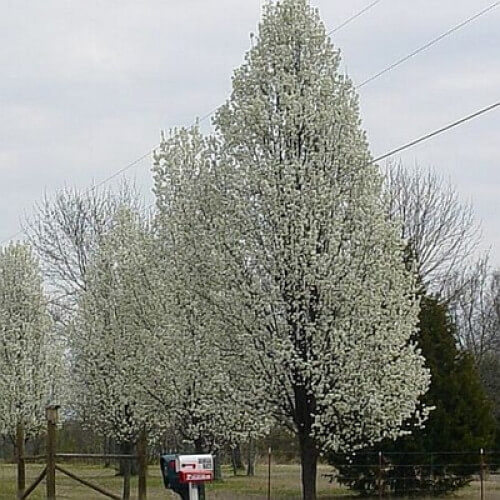 Source: onlineplanets.com.au |
Pyrus calleryana ‘Capital’Capital ornamental pear is one of the best-selling ornamental pear trees in Australia, perfect for creating a privacy screen or a side garden. It produces a spectacular display of white flowers in spring. The tree has a narrow growth habit with luscious leaves that hang vertically from the branches. The foliage has a curl shape which makes it visually pleasing and its column shape makes it possible to grow in tight spaces. In autumn, the leaves are a gorgeous purpley-red colour. | 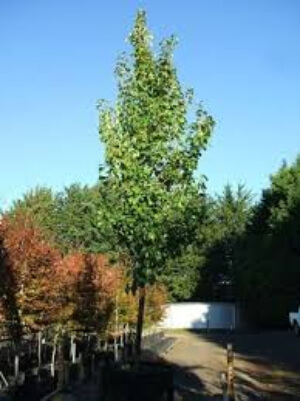 Source: olindanurseries.com.au |
Manchurian Pear (Pyrus ussuriensis)Great for cold climates and can grow up to 20 metres tall. This medium sized tree is great for shade. In late winter Manchurian ornamental pear becomes covered with single white flowers that make it look snow kissed. The summer foliage of the Manchurian pear is glossy dark green and in autumn it shows off tones of red, orange yellow and purple. This pear tree tends to lose its leaves around the end of autumn. | 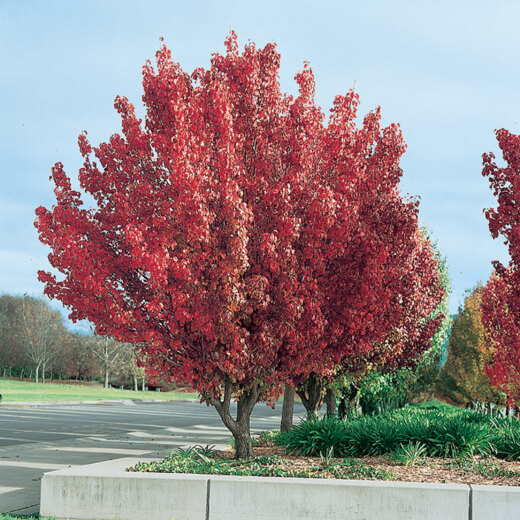 Source: flowerpower.com.au |
Pyrus calleryana 'Glen's Form'‘Glen’s Form’ produces dark green foliage and grows up to 7 metres tall. The tree is perfect for smaller gardens but you might still be surprised at how tall it grows. Its flowers appear in early spring and the leaves don’t even start to turn autumn shades until early winter, only dropping at the end of June. | 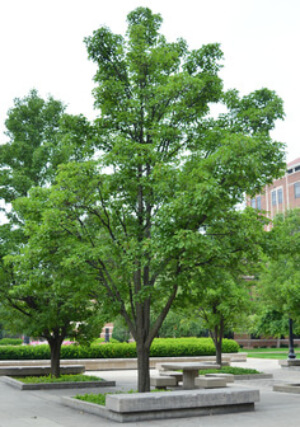 Source: mlp.arboretum.purdue.edu |
Pyrus nivalisSnow pear ornamental pear tree shows off a spectacular display of flowers for weeks during early spring. It’s also frost and drought tolerant once the tree is established. This beautiful ornamental pear covers itself in pure white flowers in late winter and early spring, with foliage that is silvery white and covered in fine down. The foliage turns to shades of yellow and orange in autumn and produces a small yellowish green fruit which smells sweet. | 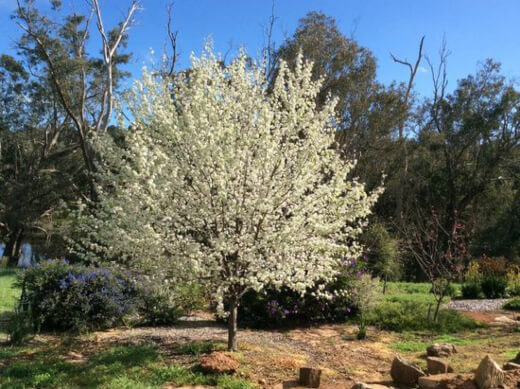 Source: thetutuguru.com.au |
Pyrus calleryana ‘Winter Glow’A hardy variety of ornamental pear that keeps its leaves throughout the winter. The colour of this tree doesn’t change until late June and into July. The leaves drop off towards the end of July with new leaves appearing in early spring. This means the winter glow ornamental pear is bare for a very short period which is great if you are trying to use it as a screen. |  Source: instanttreenursery.com.au |
Pyrus calleryana ‘Bradford’

Source: bhg.com
Bradford ornamental pear is suitable for a wide range of climate conditions. They have heart-shaped leaves, which turn multi-coloured in late autumn and boast a huge display of white flowers in spring.
This variety likes well-drained soil and to live in a sunny position. In milder climates the tree can be semi-evergreen. It can adapt to a wide range of conditions from quite dry, to slightly alkaline and/or wet soil.


Get Your Free Guide:
Master Growing Australian Natives eBook
A Must Have Complete Guide for Every Australian Garden
Get Your Free Guide:
Master Growing Australian Natives eBook
A Must Have Complete Guide for Every Australian Garden
Pyrus calleryana ‘Aristocrat’

Source: waimeanurseries.co.nz
Aristocrat ornamental pear is a fast growing and attractive ornamental pear tree with a brilliant branch structure. It’s perfect for medium to large gardens, streets and parks.
Pyrus calleryana ‘Cleveland Select’

Source: onlineplanets.com.au
Cleveland select ornamental pear prefers a well-drained soil in a sunny position. It handles a range of soil conditions including wet seasons and wind is less likely to bother this ornamental pear tree. It’s symmetrical with a pyramid shape.
Pyrus calleryana ‘Capital’

Source: olindanurseries.com.au
Capital ornamental pear is one of the best-selling ornamental pear trees in Australia, perfect for creating a privacy screen or a side garden.
It produces a spectacular display of white flowers in spring. The tree has a narrow growth habit with luscious leaves that hang vertically from the branches.
The foliage has a curl shape which makes it visually pleasing and its column shape makes it possible to grow in tight spaces. In autumn, the leaves are a gorgeous purpley-red colour.
Manchurian Pear (Pyrus ussuriensis)

Source: flowerpower.com.au
Great for cold climates and can grow up to 20 metres tall. This medium sized tree is great for shade. In late winter Manchurian ornamental pear becomes covered with single white flowers that make it look snow kissed.
The summer foliage of the Manchurian pear is glossy dark green and in autumn it shows off tones of red, orange yellow and purple. This pear tree tends to lose its leaves around the end of autumn.
Pyrus calleryana 'Glen's Form'

Source: mlp.arboretum.purdue.edu
‘Glen’s Form’ produces dark green foliage and grows up to 7 metres tall. The tree is perfect for smaller gardens but you might still be surprised at how tall it grows.
Its flowers appear in early spring and the leaves don’t even start to turn autumn shades until early winter, only dropping at the end of June.
Pyrus nivalis

Source: thetutuguru.com.au
Snow pear ornamental pear tree shows off a spectacular display of flowers for weeks during early spring. It’s also frost and drought tolerant once the tree is established.
This beautiful ornamental pear covers itself in pure white flowers in late winter and early spring, with foliage that is silvery white and covered in fine down.
The foliage turns to shades of yellow and orange in autumn and produces a small yellowish green fruit which smells sweet.
Pyrus calleryana ‘Winter Glow’

Source: instanttreenursery.com.au
A hardy variety of ornamental pear that keeps its leaves throughout the winter. The colour of this tree doesn’t change until late June and into July.
The leaves drop off towards the end of July with new leaves appearing in early spring. This means the winter glow ornamental pear is bare for a very short period which is great if you are trying to use it as a screen.
How to Grow Ornamental Pear Tree
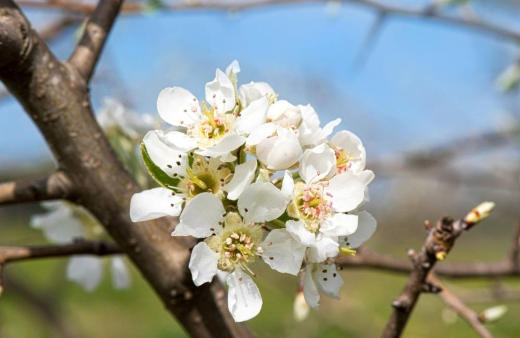
Growing Ornamental Pear Tree from a Cutting
When taking a pear tree cutting, only take from a healthy tree. Choose a green stem cutting from a branch tip that is between 0.6 -1.3 cm in width and it should have lots of growth nodes along the stem.
Pour equal part vermiculite and perlite into a planter and water. Allow any excess to drain before planting the pear cuttings. It should be just damp. Make a hole for the cutting.
Remove the bottom third of bark from the cutting and place it in water for five minutes. Then, dip the end of the pear tree cutting into rooting hormone and gently tap off any excess.
Next you’re going to place the end of the cutting into the prepared hole and pack the soil around it. If you’re planting multiple cuttings, leave some space in-between.
Cover the cuttings with a plastic bag which is tied at the top so you create a greenhouse effect. The planted cutting should be in a consistently warm area with no drafts and keep it out of direct sunlight.
The growing cutting should be kept moist, but not wet, otherwise it will rot. After about a month, you can place the pot outside in a protected area so there’s no direct sun, cold or wind.
You want to allow the tree to grow to a size where it’s big enough to handle the weather before transplanting it into the garden – about three months is a good estimate.
Growing Callery Pear from Seed
You’ll begin by soaking your seeds in a bowl of water overnight. Remove any seeds that float to the top because these won't germinate. The next morning, soak your seeds in a solution of ten parts water to one part bleach for ten minutes.
Drain your seeds and let them dry on a paper towel. Fill a sandwich bag with moist potting soil (it should be damp, not soggy). Push the seeds 5 to 7 centimetres deep into the soil.
Seal the bag and put it into your refrigerator drawer. Allow the seeds to germinate for three months and check the moss every two weeks to make sure it hasn’t dried out. If it has, you can add more water.
You can remove the seeds from the fridge after three months if the temperature is above 4°C. Soak the seeds in a bowl of warm water for two days and throw away any seeds that float to the top.
Next, you’ll fill a small container with a potting mix (see the best potting mix selection here) and place each seed 1.5cm deep near the sides of the container and space them evenly. Water the seeds so that the soil is damp.
If you overwater you can stunt their growth or cause root rot. Place the planted seeds in a well-lit place with full sun for two to three weeks.
Keep an eye on your seeds over the next two to three weeks to make sure they sprout and start to show true leaves. When your sprouts have four true leaves, you can replant them in your garden.
Planting Ornamental Pear Tree

It is a good idea to plant your ornamental pear tree in autumn to optimise root development and renewed growth. Choose a sunny spot with well-drained soil. Dig the planting hole twice as wide and to the same depth as the root-ball.
Position the plant in the hole and refill gently. Form a raised ring of soil around the outer edge of the plant's root zone to help keep water where it's needed.
Watering Needs
You need to water well after planting to settle the soil around the roots and to keep the soil moist for several weeks while the new tree establishes.
The ornamental pear tree can handle drought but regular watering will keep it healthy. Mulching the base can help preserve moisture in a dry season.
What Soil to Use
The ornamental pear tree can tolerate most soil conditions, including alkaline or clay soils. It prefers slightly acidic, well-drained soil, but by nature it can be planted in difficult areas where other trees are hard to grow. Many ornamental pear trees can handle intermittent periods of wet soil.
Sunlight
This tree needs at least six hours of full sun per day to thrive and bear flowers and fruit.
How to Care for Callery Pear
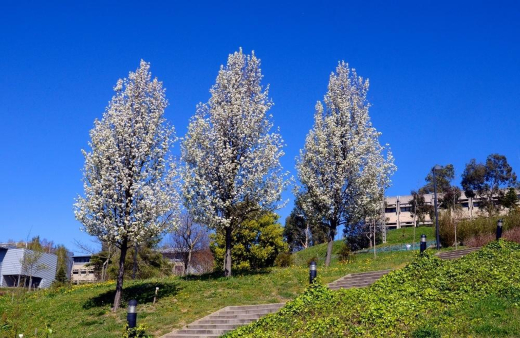
Pruning Ornamental Pear Tree
Pruning is so important if you want to maintain your ornamental pear tree's appearance. If you cut back too much each year you’ll get fewer flowers in spring, so don’t be too enthusiastic with the pruning shears.
The best time to prune an ornamental pear tree is at the end of autumn. These trees can be vulnerable to losing branches, and because they also grow quickly, the tree can start to look asymmetrical – maybe not what you had in mind for your landscape garden.
If you do careful and regular pruning in the first few years after planting your tree, it can help maintain the tree’s shape and form. It also means the tree won’t be as vulnerable to storm and wind damage.
Fertilising Callery Pear
If you want to give your ornamental pear tree a good quality of life for many years, you can fertilise twice a year in autumn and spring to aid strong root development, healthy leaves and flowers.
Mulch
Mulch around the base of your ornamental pear tree with organic mulch like bark chips, sugarcane or pea straw, and make sure you keep it away from the trunk.
Not sure which mulch is best? Check out our guide on the best mulch for your garden along with when and how to use it. Learn more about the basics of garden mulching.
Watering Pyrus calleryana
You need to water the tree deeply, once or twice a week, depending on weather conditions.
Commons Problems with Ornamental Pear Tree
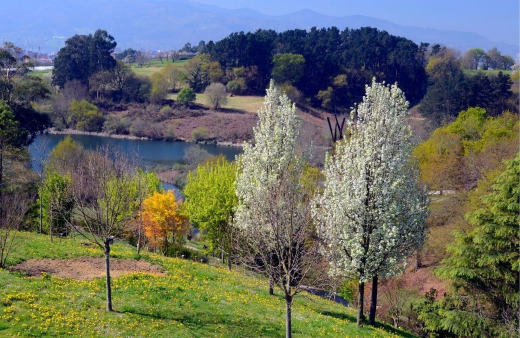
Branches and Trunk are Splitting Due to the Weather
Pear wood is usually quite hard and durable but ornamental pear trees are prone to splitting problems. The way their branches form cause the trees, with age, to lose large branches or even parts of the trunk in stormy weather.
There is not much you can do about this. It might be possible that your tree will have a short lifespan.
Withered and Dead Blossoms
Fireblight - this fungus is one of the most serious enemies of pear trees but they are actually quite resistant to this disease. It helps if you can recognise the fungus as you can control it by correctly fertilising and pruning your tree and by planting resistant varieties.
So what are you looking for? Shoots that are infected with fireblight turn brown or black and the blossoms wither and die. You’ll see bark lesions that are reddish in colour, and on warm days they ooze an orange-brown liquid, later becoming brown and dry.
Your best defence against fireblight is to prune, prune and then prune some more. In the winter you want to look for branches with visible lesions and prune them off just a few centimetres below the spot.
On branches too large to remove, cut off the skin and outer layer of the diseased tissues. In summer, look out for black leaves, stems or fruits and cut them off 30 centimetres below any sign of disease.
You can disinfect your pruning tools by dipping them for a few seconds in a solution of hot water and household bleach after each cut.
Foliage is Curling, Puckering and Turns Yellow
Aphids - if the foliage on your pear trees curls, puckers and turns yellow, and the flowers become stunted, you’re most likely dealing with aphids. Look out for clumps of soft and pear-shaped insects (the size of a pin head is a good reference) on the undersides of young leaves.
The aphids could be green, brown or pink. If you see ants on the tree as well it’s also a good indicator of aphids. The ants are attracted to a sticky honeydew secreted by aphids.
If you have a small tree and can reach the foliage, spray the aphids with a strong water spray first thing in the morning and once every other day for three days.
Ornamental Pear Tree is Defoliated
Gypsy Moth - Newly hatched gypsy moth caterpillars are grey and have long brown hairs. Their eggs are light brown to yellow and are laid by adult moths on tree trunks and branches.
Masses of caterpillars can eat tree foliage to the point where they defoliate the entire tree.
Leaves have Yellow Speckles
Mites - Mites are about the size of a grain of black pepper and can be red, black, or brown. Pear tree leaves that have speckles/blotches, are yellow and dried indicate spider mites.
These pests suck the chlorophyll from the leaves and this is what causes the spots to appear. The mites also inject toxins into the leaves, causing them to discolour and distort.
If your tree is small and young, you can spray the foliage with a strong stream of water in the morning three times. Follow this up with a spray once every other day to disrupt the mite life cycle and knock them off the leaves.
Some gardeners find that dealing with a worm infestation is a common problem – after refreshing summer rains, they can end up inside your home after emerging from the garden. Here are some tips for managing these pests.
Ornamental Pear Tree FAQs
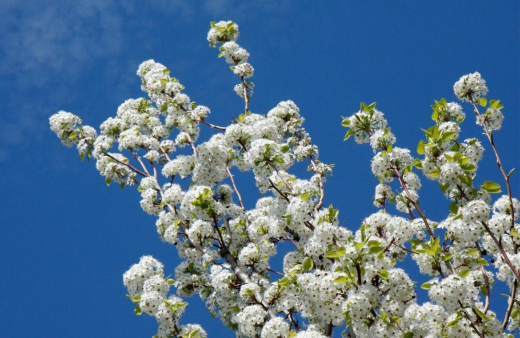
Is the ornamental pear tree invasive?
This tree and its varieties do have invasive abilities which help it to spread quickly. It is possible that it will appear on an official invasive species list in the future.
How long does the ornamental pear tree live?
The life span of this tree is usually less than twenty-five years. You might get more years if you care for your tree in a way that looks after its weak points. Some of these challenges are that it grows vertically and without forming well-angled branches.
Are ornamental pear trees poisonous?
Pyrus calleryana seeds are mildly poisonous to humans. If the seeds are ground between the teeth and eaten in large amounts, glycosides in the seeds mix with stomach acid and it forms cyanide. Yikes!
What is the ornamental pear tree used for?
This tree has quite a few uses. These include:
- They are often used as a rootstock for grafting various pear cultivars
- The wood of this tree is hard and close-grained. It is used for making furniture and woodwind instruments.
Looking for more trees you can grow in your garden? The Australian native Davidson's plum would not only be a great addition to your garden but also it's fruit in your kitchen.
Enjoy Growing Ornamental Pear Trees
Ornamental pear trees are elegant but not overpowering. For those who are developing a formal garden, it has become an obvious choice of tree that will enhance a growing garden.
These ornamental pear trees are loved for their glossy green leaves that become the most brilliant autumn shades as the seasons turn. The soft white flowers that appear in springtime are a treat for the eyes, as they look kissed by the sunshine.
These lovely qualities mean the ornamental pear tree represents all the seasons and seems to keep time like a clock of nature.
The slender trunk of an ornamental pear tree is ideal for creating shade without compromising your view. Pleasing and practical – that seems like a good reason to plant a tree.

Published on March 3, 2022 by Maisie Blevins
Last Updated on September 20, 2025




